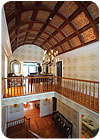
Regardless of its vexing pronunciation, a foyer speaks volumes about its surroundings. While its purpose is to welcome guests, the foyer is also an indication of architectural style and, in the case of a private residence, the occupant’s personal taste.
One Illinois homeowner – well aware that you never get a second chance to make a first impression – realized the front entrance to her home was seriously lacking style and appeal. She enlisted custom woodworker Mark Miller to transform the front hall of her Chicago-area abode from nondescript to one that makes a dramatic statement about her home and personality.
“This particular house was only about 5 years old, but the homeowner never liked the front entrance,” Miller explains. “There was a high angled ceiling about 27 feet up that was basically blank drywall and very plain. The homeowner challenged me to come up with something more decorative and visually interesting.”
The goal was to achieve a Federal-style look to the space. Federal-style architecture in the United States, popular in era from 1785 to 1815, was influenced by Georgian neoclassical style. Hallmarks of American Federal style architecture include the use of symmetry, attenuated detail and curved lines.
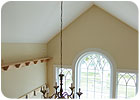
BEFORE
Curve Appeal
Miller, who counts building from scratch an exact replica of the Wright brothers’ first propeller-driven airplane among his repertoire of unique woodworking projects, relished the challenge. “I came up with the idea of creating a curved coffer ceiling for the space and further accenting it with tin ceiling panels in the grid for even more design interest,” he says.To accent each grid in the wood coffer, Miller chose ACP’s classic tin style ceiling panels style in a cracked copper finish because it fit perfectly with the style of this particular home. “I came across them one day when I was at a home center and I thought they’d be great for this project,” he says.
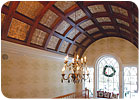
AFTER
Durable, Affordable, Irresistible
In addition to their authentic look, the decorative panels are less expensive than real metal panels and come in 19 unique finishes.“Tin panels can run as much as $55 apiece and we were going to have 54 panels, so that would have been quite cost-prohibitive. These were much more affordable,” Miller says. “Because they’re made of a thermoplastic material, I knew they’d conform really well to the curve we were creating.”
In addition, the panels will not corrode and will be resistant to wear and tear. “Durability was especially important to the homeowner because these were going to be installed more than 25 feet above the floor,” he says. “Getting to them once installed would have been a major hassle, so we wanted to be sure we used something that would stand the test of time.”
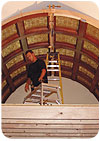
All in a Week's Work
The homeowner loved Miller’s idea and enthusiastically accepted his proposal. The busy mother of five, however, had one caveat: The actual installation would need to take place over a one-week time period while the family was away on vacation so there would be as little disruption to their lives as possible.Miller didn’t bat an eye. “I love a challenge and I really enjoy unusual projects. I don’t do anything twice,” he says. “I was confident we could pull this off, but I knew we had to plan for every eventuality to make sure it’d be finished before the family returned home.”
The first step in the process was to take detailed, accurate measurements of the space. Miller and his employee, Peter Dorger, spent the better part of an afternoon making sure they got accurate data to take back to the woodworking shop. The finished product would consist of 54 2-foot-by-2-foot ceiling panels framed in wood.
“We drew it on AutoCAD, which is nice because you can draw it full size,” Miller says of the design. “Then we actually drew it out full size on several sheets of wood that we had laid on the floor of the shop.” At about 22 feet long and a little more than 12 feet in diameter, the pattern made for a tight fit in a 50-foot-by-40-foot space, he said.
Miller chose poplar for the frame because of its flexibility. Each of the nine total frames consists of two rows of three panels each. He used a bent laminating process on each frame to accomplish the curves. Each frame is constructed of three ¼-inch milled pieces of poplar. Miller laminated each frame together using bending forms and urea formaldehyde glue “because it allows for less springback,” he says. He put it all together on the shop floor to make sure it would work in the home.
The final step before heading to the house involved attaching the ceiling panels to the grids. In typical home installations, the ceiling panels can easily be laid in or glued up. But because this particular project involved such great height, Miller chose to screw down the panels to the backside of the wood with wood strips to ensure they’d never loosen.
Once he was assured everything was perfect, the wood coffer grid was disassembled at the shop and then transferred to the job site.
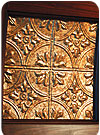
All Decked Out
Because of the challenging logistics of installing such materials more than 25 feet off the ground, Miller built a temporary deck on the second-floor landing to stand on during installation. That meant, however, the stairwell would be blocked once it was built. Each grid piece needed to be stored on the second floor before the deck was built or they wouldn’t have fit through the narrow passage. “It sounds complicated, but it was a lot easier than hauling in scaffolding,” Miller says.True to form, Miller’s planning paid off. “We were able to build the deck in one day because we had cut it to length at the shop and it was ready to assemble once we got to the site,” he says. “Having the installation go quickly was the key to the success of this undertaking.”
A Smooth Finish
Assembly of the wood coffer system went rapidly. Shelves were built on each opposing wall and were the starting point for each row. The rest followed to meet in the middle. Because it was pre-assembled, the process went swiftly.“It could have gone a lot worse than it did,” he says. “We moved the panels in on a Monday, built the deck on Tuesday, put the ceiling up and were taking the deck down by Thursday afternoon.
“I was really impressed with the ceiling tiles,” he says. “They were affordable and easy to use. I’ll definitely use them again. And the home-owner absolutely loves the look of her ceiling and the new focal point to her home. It’ll be a conversation piece for years to come and it’s really gratifying to know I was able to make that happen.”

Report Abusive Comment